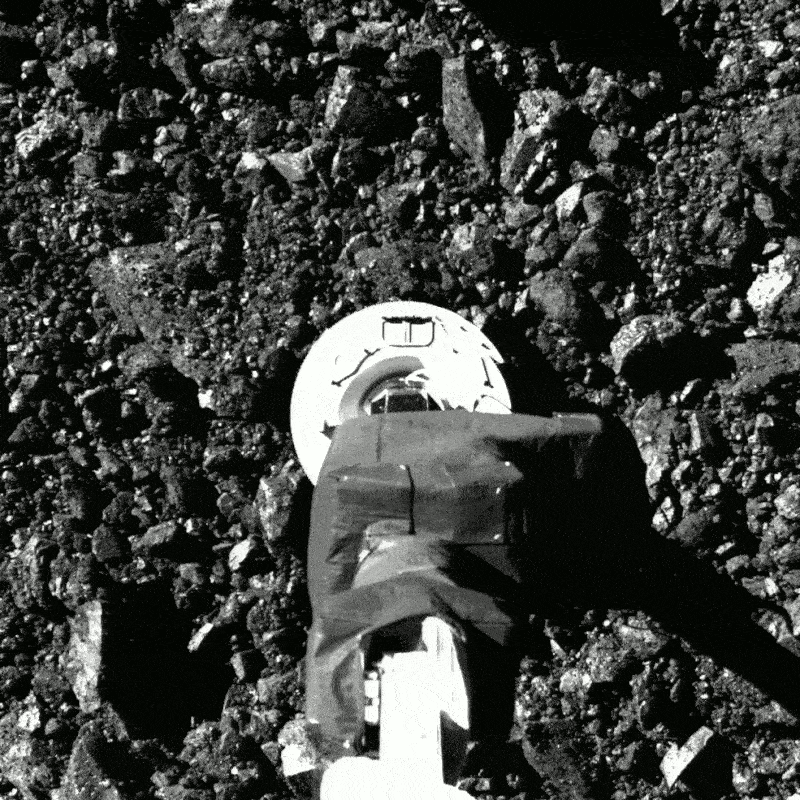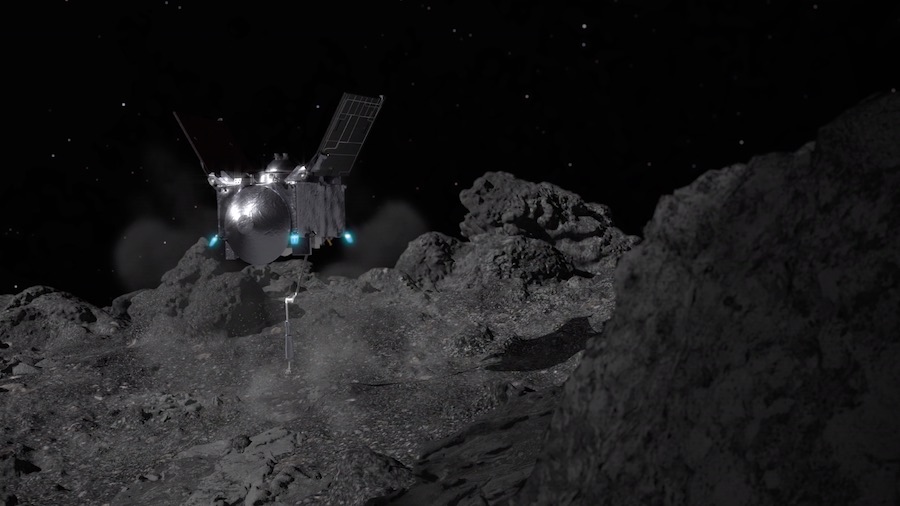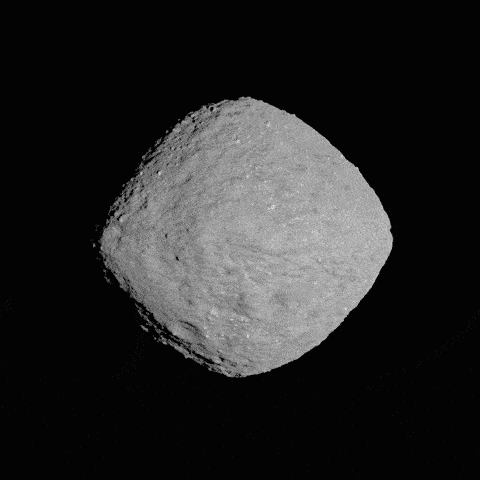The first images beamed back to Earth by NASA’s OSIRIS-REx spacecraft after it briefly landed an asteroid buoyed expectations Wednesday that the probe collected enough samples to meet the mission’s minimum requirement for return to Earth.
But it will take another week for ground teams to get a reasonably precise estimate of how much material OSIRIS-REx captured during its touch and go landing Tuesday on asteroid Bennu, a loosely-assembled clump of carbon-rich rock and dust spanning a third of a mile (about 500 meters) wide.
The diamond-shaped mini-world was the destination for NASA’s $1 billion Origins, Spectral Interpretation, Resource Identification, Security, Regolith Explorer, which aims to become the first U.S. spacecraft to complete a round-trip journey to an asteroid.
Dante Lauretta, the mission’s chief scientist from the University of Arizona, said Wednesday that the spacecraft’s 11-foot-long (3.4-meter) sampling arm appeared to come down on a “relatively large rock” that measured a little more than 8 inches, or 20 centimeters.
“Literally, we crushed it,” Lauretta said. “When the spacecraft made contact, that rock appears to fragment and shatter, which is great news because that means that ingestible material … is probably being created just by the motion of the spacecraft pushing into the surface.”
The spacecraft’s Touch And Go Sample Acquisition Mechanism, or TAGSAM, on the end of the robot arm is about the size of a dinner plate. About one second after touching the asteroid surface, the sampling system discharged a bottle of high-pressure nitrogen gas to help blow rock fragments and dust into a collection chamber, acting like a reverse vacuum cleaner.
A sped-up video sequence released Wednesday showed the sampling mechanism touching down on the asteroid and generating a cloud of debris.
Ground teams at OSIRIS-REx mission control near Denver received confirmation that the spacecraft contacted the asteroid at 6:08 p.m. EDT (2208 GMT) Wednesday, according to NASA.
In real time, the touch and go landing actually happened more than 18 minutes earlier. It took that long for radio signals from OSIRIS-REx to make the one-way trip at the speed of light from Bennu — located some 207 million miles (333 million kilometers) from Earth — back to mission control.
NASA said Wednesday that a preliminary analysis of data from OSIRIS-REx indicated the spacecraft contacted the asteroid at a relative velocity of just 0.2 mph, or 10 centimeters per second, a fraction of a walking pace. The spacecraft was on the asteroid for around six seconds before the probe fired thrusters to back away from Bennu.

The spacecraft’s autonomous navigation software guided OSIRIS-REx to an on-target touchdown, steering clear of nearby boulders and rugged terrain. The spacecraft found Bennu had a more rocky surface than expected, requiring engineers to introduce more precise navigation algorithms to use natural landmarks on the asteroid to help itself maneuver toward the correct landing site.
The target for Tuesday’s touch and go landing — nicknamed “Nightingale” — was just the size of a tennis court. In the end, OSIRIS-REx contacted the asteroid within a meter, or 3.3 feet, of its target, according to Rich Burns, OSIRIS-REx’s project manager at NASA’s Goddard Space Flight Center.
OSIRIS-REx was relaying low-rate telemetry back to ground controllers as it descended toward Bennu on Tuesday. A few hours later, the spacecraft reestablished a higher-rate data link with Earth and started beaming back images taken during the touch and go, or TAG, maneuver.
Lauretta said much of OSIRIS-REx’s science team was up late Tuesday night to begin analyzing the pictures.
“We were watching the images come down one by one,” Lauretta said.
Finally, well after midnight in Denver, the science team got the picture they were looking for. The craft’s robotic arm appeared to press into the asteroid’s porous surface, and the burst of nitrogen gas launched a cloud of tiny particles off Bennu and into the sampling camera’s field-of-view.
“You can see that particle are flying all over the place,” Lauretta said. “We really did kind of make a mess on the surface of this asteroid, but it’s a good mess. It’s the kind of mess we were hoping for. Lots of material has been mobilized giving us additional confidence that we actually pushed material up into the sampler head.”
Lauretta was in contact with imaging scientists at the University of Arizona in Tucson via a virtual chat app as each new photo arrived on Earth overnight.
“The science team was analyzing them in real-time through the chat feature,” Lauretta said. “As you can imagine, the chat was filled with emojis and wows and all kinds of celebratory remarks.
“The best piece of information we got was that that TAGSAM head looked like it pushed down into the asteroid surface,” he said.
The nitrogen gas bottle was expected to drive rock fragments of up to 2 centimeters — about the size of a U.S. nickel — into OSIRIS-REx’s sample collection chamber. Stainless steel Velcro pads on the outside of the sampling device were also supposed to collect fine-grained dust.

Lauretta said the science team was encouraged by the indications that OSIRIS-REx’s sampling mechanism crushed the rocks when it contacted the asteroid. He said the sampling system performed best in pre-launch testing when it pressed into the ground.
“Everything that we can see from these initial images indicate sampling success,” Lauretta said. “We still have some work to do.”
On Thursday, the spacecraft will move its robot arm into position to allow a camera to take closer images of the sample collection mechanism. Officials hope to see asteroid material inside the sampling device, but Lauretta said there’s no guarantee of getting a clear shot of the sample.
OSIRIS-REx will fire its thrusters Friday to halt its flight away from Bennu after the touch and go landing earlier this week, Burns said.
The next activity will be a sample mass measurement Saturday, when OSIRIS-REx will extend its sampling arm and enter a spin to give ground teams an estimate of how much asteroid material it scooped up from Bennu. The spacecraft performed a similar spin maneuver before the touch and go landing.
“That way we can compare the moment of inertia, which will help us determine how much mass is actually in the sampler head,” said Sandra Freund, OSIRIS-REx mission operations manager at Lockheed Martin, which built the spacecraft for NASA.
The minimum amount of asteroid material OSIRIS-REx needs to return to meet mission success criteria is 60 grams, or about 2.1 ounces.
“The best outcome would be that we would collect a massive sample,” said Heather Enos, OSIRIS-REx’s deputy principal investigator at the University of Arizona, before the sample collection attempt. “We say we have a requirement for 60 grams, or 2 ounces, but we have the capability of collecting up to 2 kilograms. I would love for that capsule to be completely full.”
Lauretta said Wednesday that the sample mass measurement has some uncertainty, and a measurement of 80 grams would give managers some confidence that OSIRIS-REx gathered the required amount of material from Bennu.
“If we see SMM (the sample mass measurement) coming in at 80 grams or higher, we have a 90% confidence of having collected 60 grams of regolith,” Lauretta said. “So that’s a key number that I’m looking for.”
NASA has set Oct. 30 for a key decision point on whether to declare success, or plan for another sampling run at a different site on Bennu.
If NASA is satisfied OSIRIS-REx has the required sample mass, ground controllers will send commands for the TAGSAM arm to place the collection canister inside OSIRIS-REx’s landing capsule. Explosive bolts will sever the TAGSAM head from the craft’s robotic arm, and the capsule’s lid will close over the device for the trip home.
If not, the spacecraft could try another touch and go landing as soon as January to snatch up more asteroid material.
The robot explorer is scheduled to depart the vicinity of Bennu in March, when it can set off on an interplanetary trajectory back to Earth. OSIRIS-REx is scheduled to release its return capsule to parachute to a landing in the Utah desert on Sept. 24, 2023.
After OSIRIS-REx’s return carrier lands back on Earth, a recovery team will transport the craft to NASA’s Johnson Space Center in Houston, where scientists will open the canister inside a pristine sample curation laboratory and begin studying its contents.
Researchers at Johnson’s astromaterials lab also analyze rocks returned from the moon by the Apollo astronauts.

The team that developed and built the OSIRIS-REx spacecraft took extra measures to ensure the asteroid sample will not be contaminated by organic materials from Earth.
Researchers will use optical and electron microscopes, super-computing labs, and synchrotron accelerators — instruments the size of a large room or a building — in their asteroid sample analysis.
Scientific equipment qualified to fly in space have to operate in extreme temperatures, an airless vacuum, and intense radiation, all while functioning on very little power.
Scientists will attempt to determine the chirality, or handedness, of amino acids and other compounds grabbed from Bennu. Molecules associated with life, such as DNA, have a distinctive orientation. In the case of DNA in organisms on Earth, the double helix always twists in a right-handed direction, and the atoms that make up amino acids in biology are almost always left-handed.
The preference for a left or right orientation among the atoms making up biological molecules makes it easier for chemicals to latch together and build more complex structures.
“Bennu is one of over a million known asteroids in our solar system, and these asteroids are relics of that earliest material that formed the planets in the solar system, and they hold the key information to unlocking how the solar system formed, and how it evolved over time,” said Lori Glaze, director of NASA’s planetary science division.
Named for a bird-like ancient Egyptian deity linked with the sun, creation and rebirth, Bennu follows a path around the sun that intersects Earth’s orbit, and the asteroid makes a relatively close approach to Earth once every six years.
That makes Bennu a potentially hazardous asteroid, and it poses a low threat of eventually hitting Earth. There is a 1-in-2,700 chance of Bennu impacting Earth in the late 2100s.
Bennu was discovered in 1999 by a survey with a ground-based telescope searching for near-Earth asteroids. OSIRIS-REx is the first mission to visit Bennu.
Since arriving at Bennu nearly two years ago, OSIRIS-REx has determined the asteroid is shedding material into space. The mission has also found that Bennu — known as a B-type asteroid — is covered in carbon-rich, water-bearing minerals. The organic material may contain carbon in a form often found in biology or in compounds associated with biology, scientists announced Oct. 8.
Data from OSIRIS-REx’s surveys of Bennu show many of the asteroid’s darkest boulders are weaker and more porous than expected. Scientists say most of the boulders on the asteroid are too weak to survive entry into Earth’s atmosphere, so the specimens targeted by OSIRIS-REx could offer a “missing link” because similar rocks are not well represented in meteorite collections.
“Returned samples from Bennu could help us answer some key astrobiology questions, such as how water and organic materials were delivered to Earth, and the role those key ingredients played in the early initiation of life on Earth,” Glaze said.
Another objective of the OSIRIS-REx mission is to characterize the forces pushing on Bennu and gradually changing its orbit. One of the forces is called the Yarkovsky effect, in which thermal emissions from an asteroid can alter its trajectory through the solar system. Solar radiation pressure is another influence on asteroid orbits.
That data will help scientists better predict when asteroids might threaten Earth.
While it is the first U.S. asteroid sample return probe, OSIRIS-REx is not the only spacecraft currently traveling the solar system on a mission to retrieve materials from an asteroid and bring them back to Earth.
Japan’s Hayabusa 2 spacecraft is on course to bring home samples from asteroid Ryugu on Dec. 6, capping a six-year expedition in space. The mission captured bits of rock from two locations on the half-mile-wide (900-meter) asteroid last year.
Like Bennu, Ryugu is an asteroid rich in carbon and organics.
NASA and the Japan Aerospace Exploration Agency have agreed to share Hayabusa 2 and OSIRIS-REx samples with scientists in each country. JAXA will get about 0.5% of OSIRIS-REx’s samples from Bennu, according to Lauretta.
The Canadian Space Agency will receive 4% of the material from Bennu in exchange for Canada’s contribution of a laser altimeter for OSIRIS-REx, Lauretta said.
Assuming the sample mass measurement Saturday confirms scientists’ suspicions that OSIRIS-REx gathered more than 60 grams of samples from Bennu, the spacecraft’s science mission at Bennu is over, Lauretta said.
“We are then solely focused on the return cruise,” he said. “And quite honestly, the real scientific payoff which this mission is designed to do is that sample return and that sample science, and we’ll be putting our focus and our resources into that.
“We have met, and in most cases, vastly exceeded all the science requirements associated with the remote sensing campaign at Bennu,” Lauretta said Wednesday. “So all we have left to do to deliver on our promise to the agency is get that sample safely back to the Earth, get it into our laboratories, and answer the fundamental questions about the formation of our solar system and why Earth is a habitable world.”
Email the author.
Follow Stephen Clark on Twitter: @StephenClark1.



